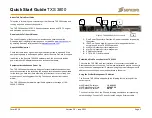
GEAFOL- / CARECO-Cast-resin Transformer/ Operating Instructions
© 2021 Siemens Energy
Page 13
5.11
Ventilation of the
transformer room
Every transformer has heat loss occurs during the opera-
tion. This heat must be dissipated from the transformer
room.
A good cooling effect is achieved if the cooling air flows in
at the bottom of the room and flows out at the top of the
room
(see Fig. 5-11).
The cooling type is shown on the nameplate. The code of
the cooling type is shown in Table 5-2.
Note:
A transformer designed up to a defined rated power with
natural ventilation cooling, and for a higher rated power
with forced cooling, is marked with ON/AF.
CAUTION!
Operate the transformer at least with the type of cooling
specified on the nameplate.
Make sure that the ventilation ducts are not covered. If the
supply air is heavily polluted, it must be filtered.
Make sure that there is no condensation above the trans-
former that steadily drips into the transformer.
If the transformer is regularly switched off for several days,
make sure that no condensation occurs during this time.
This prompts the transformer to become dirty.
If the cooling effect is too low, a ventilation system can be
retrofitted.
Housing for outdoor installation
In the event of a storm or heavy rain, water may enter the
interior of the transformer through the ventilation slots. In
this case, make sure that there is a water drain to avoid
larger accumulations of water inside the housing.
DANGER!
Water accumulation inside the transformer housing can
lead to flashovers outside the transformer housing!
WARNING!
The surface temperature on the housing can exceed
55°C degrees.
For more information please see the brochures at following
link:
https://www.siemens-energy.com/geafol
Fig. 5-12: Minimum clearances around GEAFOL cast-resin
transformers with bare tappings and delta connection
tubes
Fig. 5-13: Ventilation of transformer room
Symbol
Cooling medium
Air
A
Water
W
Type of circulation Natural
N
Forced
F
Table 5-2: Symbols of cooling method











































